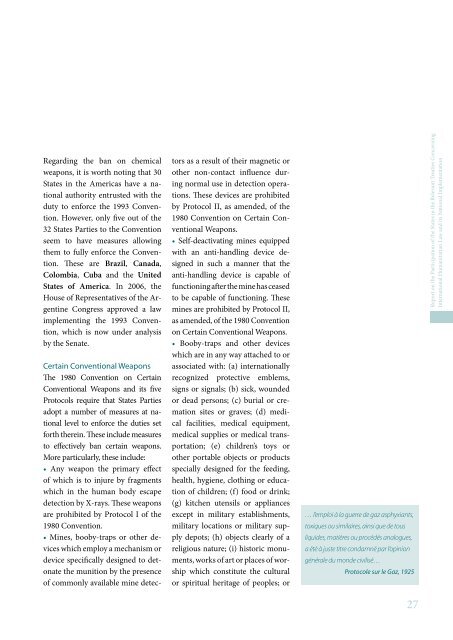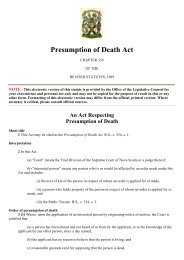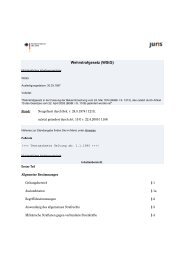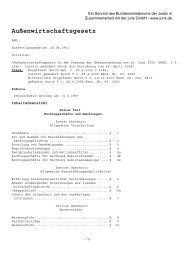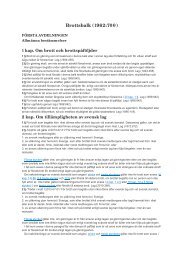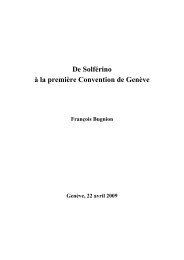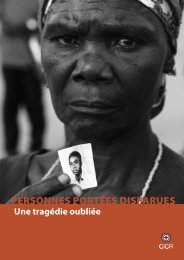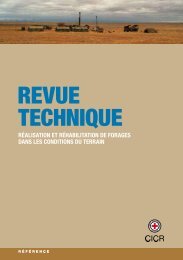Full text in PDF format - International Committee of the Red Cross
Full text in PDF format - International Committee of the Red Cross
Full text in PDF format - International Committee of the Red Cross
You also want an ePaper? Increase the reach of your titles
YUMPU automatically turns print PDFs into web optimized ePapers that Google loves.
Regard<strong>in</strong>g <strong>the</strong> ban on chemical<br />
weapons, it is worth not<strong>in</strong>g that 30<br />
States <strong>in</strong> <strong>the</strong> Americas have a national<br />
authority entrusted with <strong>the</strong><br />
duty to enforce <strong>the</strong> 1993 Convention.<br />
However, only five out <strong>of</strong> <strong>the</strong><br />
32 States Parties to <strong>the</strong> Convention<br />
seem to have measures allow<strong>in</strong>g<br />
<strong>the</strong>m to fully enforce <strong>the</strong> Convention.<br />
These are Brazil, Canada,<br />
Colombia, Cuba and <strong>the</strong> United<br />
States <strong>of</strong> America. In 200 , <strong>the</strong><br />
House <strong>of</strong> Representatives <strong>of</strong> <strong>the</strong> Argent<strong>in</strong>e<br />
Congress approved a law<br />
implement<strong>in</strong>g <strong>the</strong> 1993 Convention,<br />
which is now under analysis<br />
by <strong>the</strong> Senate.<br />
Certa<strong>in</strong> Conventional Weapons<br />
The 19 0 Convention on Certa<strong>in</strong><br />
Conventional Weapons and its five<br />
Protocols require that States Parties<br />
adopt a number <strong>of</strong> measures at national<br />
level to enforce <strong>the</strong> duties set<br />
forth <strong>the</strong>re<strong>in</strong>. These <strong>in</strong>clude measures<br />
to effectively ban certa<strong>in</strong> weapons.<br />
More particularly, <strong>the</strong>se <strong>in</strong>clude:<br />
• Any weapon <strong>the</strong> primary effect<br />
<strong>of</strong> which is to <strong>in</strong>jure by fragments<br />
which <strong>in</strong> <strong>the</strong> human body escape<br />
detection by X-rays. These weapons<br />
are prohibited by Protocol I <strong>of</strong> <strong>the</strong><br />
19 0 Convention.<br />
• M<strong>in</strong>es, booby-traps or o<strong>the</strong>r devices<br />
which employ a mechanism or<br />
device specifically designed to detonate<br />
<strong>the</strong> munition by <strong>the</strong> presence<br />
<strong>of</strong> commonly available m<strong>in</strong>e detec-<br />
tors as a result <strong>of</strong> <strong>the</strong>ir magnetic or<br />
o<strong>the</strong>r non-contact <strong>in</strong>fluence dur<strong>in</strong>g<br />
normal use <strong>in</strong> detection operations.<br />
These devices are prohibited<br />
by Protocol II, as amended, <strong>of</strong> <strong>the</strong><br />
19 0 Convention on Certa<strong>in</strong> Conventional<br />
Weapons.<br />
• Self-deactivat<strong>in</strong>g m<strong>in</strong>es equipped<br />
with an anti-handl<strong>in</strong>g device designed<br />
<strong>in</strong> such a manner that <strong>the</strong><br />
anti-handl<strong>in</strong>g device is capable <strong>of</strong><br />
function<strong>in</strong>g after <strong>the</strong> m<strong>in</strong>e has ceased<br />
to be capable <strong>of</strong> function<strong>in</strong>g. These<br />
m<strong>in</strong>es are prohibited by Protocol II,<br />
as amended, <strong>of</strong> <strong>the</strong> 19 0 Convention<br />
on Certa<strong>in</strong> Conventional Weapons.<br />
• Booby-traps and o<strong>the</strong>r devices<br />
which are <strong>in</strong> any way attached to or<br />
associated with: (a) <strong>in</strong>ternationally<br />
recognized protective emblems,<br />
signs or signals; (b) sick, wounded<br />
or dead persons; (c) burial or cremation<br />
sites or graves; (d) medical<br />
facilities, medical equipment,<br />
medical supplies or medical transportation;<br />
(e) children’s toys or<br />
o<strong>the</strong>r portable objects or products<br />
specially designed for <strong>the</strong> feed<strong>in</strong>g,<br />
health, hygiene, cloth<strong>in</strong>g or education<br />
<strong>of</strong> children; (f) food or dr<strong>in</strong>k;<br />
(g) kitchen utensils or appliances<br />
except <strong>in</strong> military establishments,<br />
military locations or military supply<br />
depots; (h) objects clearly <strong>of</strong> a<br />
religious nature; (i) historic monuments,<br />
works <strong>of</strong> art or places <strong>of</strong> worship<br />
which constitute <strong>the</strong> cultural<br />
or spiritual heritage <strong>of</strong> peoples; or<br />
… l’emploi à la guerre de gaz asphyxiants,<br />
toxiques ou similaires, a<strong>in</strong>si que de tous<br />
liquides, matières ou procédés analogues,<br />
a été à juste titre condamné par l’op<strong>in</strong>ion<br />
générale du monde civilisé…<br />
Protocole sur le Gaz, 1925<br />
2<br />
Report on <strong>the</strong> Participation <strong>of</strong> <strong>the</strong> States <strong>in</strong> <strong>the</strong> Relevant Treaties Concern<strong>in</strong>g<br />
<strong>International</strong> Humanitarian Law and its National Implementation


